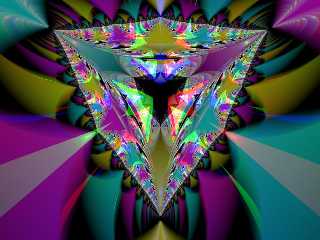 |
 |
|
 |
|
 |
|  |
|  |
|
 |
|
 |
|  |
|  |
|
 |
Okay, here's a hopefully different take on reflective spheres. It was
done by taking four reflective spheres and stacking them in a
tetrahedra. The camera is set to sight through one of the gaps between
the spheres, while red, green, and blue lights shine through each of
the remaining gaps. The lights are point lights set 122 units from the
origin, and each has a backdrop consisting of a white plane behind it.
POV 3.1 and a max_trace_level of 50.
Post a reply to this message
Attachments:
Download 'spheres.jpg' (74 KB)
Preview of image 'spheres.jpg'

|
 |
|  |
|  |
|
 |
|
 |
|  |
|  |
|
 |
Mitch Richling did something similiar to this for the IRTC:
http://www.irtc.org/ftp/pub/stills/2002-04-30/mjr_win2.jpg
~Sam Benge
Parvey wrote:
> Okay, here's a hopefully different take on reflective spheres. It was
> done by taking four reflective spheres and stacking them in a
> tetrahedra. The camera is set to sight through one of the gaps between
> the spheres, while red, green, and blue lights shine through each of
> the remaining gaps. The lights are point lights set 122 units from the
> origin, and each has a backdrop consisting of a white plane behind it.
> POV 3.1 and a max_trace_level of 50.
>
>
>
> ------------------------------------------------------------------------
>
Post a reply to this message
|
 |
|  |
|  |
|
 |
|
 |
|  |
|  |
|
 |
That's a very nice image.
--
#local i=.1;#local I=(i/i)/i;#local l=(i+i)/i;#local ll=(I/i)/l;box{<-ll,
-((I/I)+l),-ll><ll,-l,ll>pigment{checker scale l}finish{ambient((I/l)/I)+
(l/I)}}sphere{<i-i,l-l,(I/l)>l/l pigment{rgb((I/l)/I)}finish{reflection((
I/l)/I)-(l/I)specular(I/l)/I}}light_source{<I-l,I+I,(I-l)/l>l/l} // Steve
Post a reply to this message
|
 |
|  |
|  |
|
 |
|
 |
|  |
|
 |




![]()